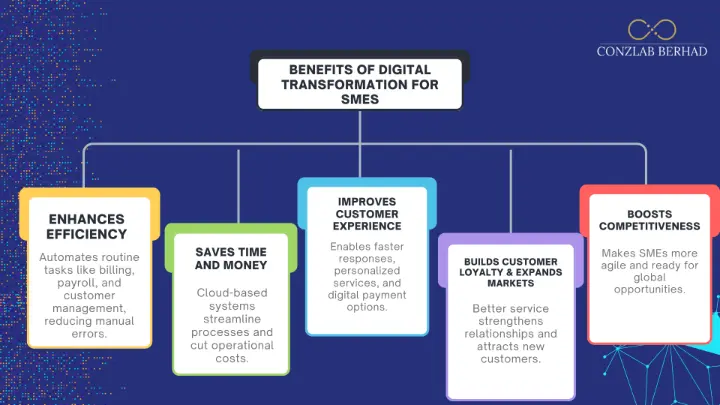Introduction to Digital Transformation
Digital transformation is no longer just a trend but a necessity for SMEs to stay competitive. It means using technology to streamline work, improve customer engagement, and make smarter decisions. SMEs can begin with simple steps like digitizing invoices, automating tasks, or selling online, before moving to tools like cloud systems, analytics, and CRM.
While it may feel costly or complex, adopting digital tools gradually makes the process manageable. With the right plan and guidance, SMEs can boost efficiency, cut costs, and open doors to new markets.
Advantages of Embracing Digital Transformation for SMEs

Common Issues Faced by SMEs in Digital Transformation
Lack of technical knowledge
- Business owners may not know which digital tools fit their industry.
- Leads to poor or irrelevant technology investments.
Employee resistance
- Staff may be unfamiliar with digital tools.
- Fear of automation replacing jobs.
- Slows down adoption and reduces impact.
Financial constraints
- SMEs often operate on limited budgets.
- Struggle to fund new systems, training, or software.
Cybersecurity risks
- Going digital exposes SMEs to online threats.
- Without proper protection, data and operations are vulnerable.
Practical Solutions for SMEs
Take a phased approach
- Start small by digitizing basic processes (e.g., accounting, communication, payment systems).
- Use affordable cloud platforms (e.g., Google Workspace, QuickBooks).
- Gradually scale to advanced tools (e-commerce, CRM, ERP).
- Ensures smooth adoption without overwhelming the business.
Invest in employee training & upskilling
- Provide workshops, online courses, and digital literacy programs.
- Helps employees embrace change and improve productivity.
- Reduces fear of automation by building confidence.
Partner with IT solution providers
- Collaborate with experts to identify cost-effective, secure tools.
- Get guidance tailored to specific business goals.
- Ensures the right balance between affordability, security, and scalability.
Adopt the right mindset
- View digital transformation as an opportunity, not a burden.
- With planning and support, SMEs can overcome barriers and thrive.
Tips for a Successful Digital Transformation
Develop a clear digital roadmap
- Define short-term & long-term goals (e.g., efficiency, customer reach, remote work).
- Set measurable objectives to track progress.
- Regularly evaluate tools & strategies to maximize ROI.
Prioritize cybersecurity from day one
- Implement strong passwords, regular data backups, and firewalls.
- Train employees with awareness programs to prevent human errors.
- Work with reputable digital service providers to reduce risks.
Balance planning with security
- Align digital adoption with business integrity.
- Ensure every investment is secure, scalable, and impactful.
For SMEs, every small step toward digital adoption opens the door to bigger opportunities.
Not necessarily. SMEs can start small with affordable tools like cloud accounting software, online payment platforms, or basic CRM systems. Over time, they can scale up as the business grows.
Most modern digital tools are user-friendly and come with training or support. Business owners can also provide short training sessions or engage local experts to guide the transition.
Start by identifying your pain points—whether it’s billing, customer management, or sales tracking. Then, choose tools that directly solve those issues before expanding to more advanced systems.
Digital Transformation Journey for SMEs